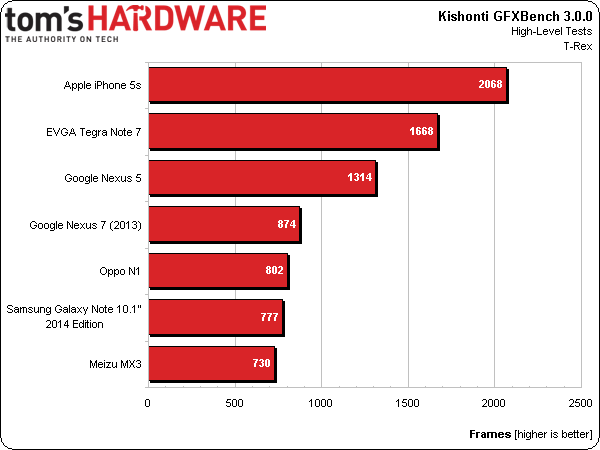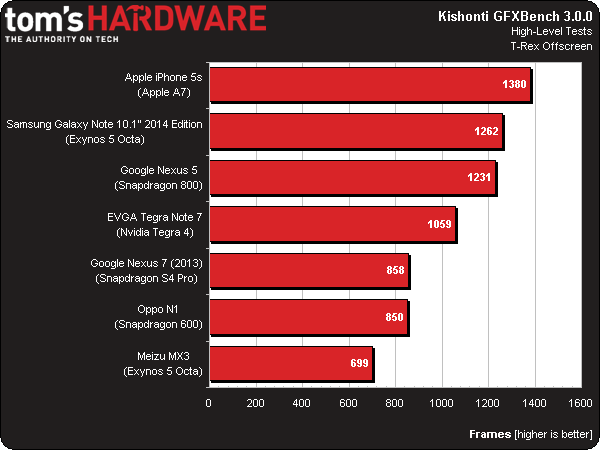GFXBench 3.0: A Fresh Look At Mobile Benchmarking
Over the past few years, Kishonti has become a leading name in mobile GPU benchmarking. The newly-released GFXBench 3.0 is comprised of nearly all new tests, including battery, render quality, and the first serious OpenGL ES 3.0 performance metric.
High-Level Test Results: T-Rex
T-Rex remains a demanding OpenGL ES 2.0 test that utilizes many modern effects, including materials, high-res textures, motion blur, parallax mapping, and complex particle systems. It also uses complex geometry, planar reflections, specular highlights, and soft shadows as part of the render pipeline.
On-Screen
All of our devices are able to run this OpenGL ES 2.0-based benchmark so let’s see how they handle it at their respective native resolutions.
Not surprisingly, Apple's iPhone 5s leads yet again, and its sub-720p resolution even helps it beat out the Tegra Note 7 (an 800p device) by over 20%. The Nexus 5 does well in third place, given its FHD native resolution. It's only 20% slower than the EVGA Tegra Note 7 and 36% slower than the iPhone 5s. That’s pretty impressive considering it's pushing at least twice as many pixels as the other two devices.
Google's Nexus 7 beats out the Oppo N1, which is interesting for two reasons. First, the Oppo N1 is powered by a Snapdragon 600 SoC, while the Nexus 7 uses the older Snapdragon S4 Pro. Yes, they both have the same Adreno 320 GPU core. But the Nexus 7 has a higher native resolution. Also, it operates at a lower clock rate. It seems Oppo is suffering for its Android 4.2-based ColorOS, while native Android 4.4.2 works in the Nexus 7’s favor.
The two Exynos 5 Octa-based devices trade blows in last place. The Note’s Exynos 5 Mali-T628MP6 GPU core suffers for its massive native resolution. Nevertheless, the Samsung tablet still manages to beat out the Meizu MX3. Its PowerVR SGX544MP3 is really beginning to show its age; it was originally used in the iPhone 5, and now in the poorly-selling budget-oriented 5c.
Off-Screen
We have a bit of a reshuffle, but Apple's iPhone 5s is still in the lead, its PowerVR Series 6 GPU a leader in this benchmark.
The Galaxy Note 10.1” 2014 jumps from second-to-last up to second place. Google's Nexus 5 continues its hold on third place. The EVGA falls from second place to fourth, hampered by the increased demand of 1920x1080 (perhaps a result of its 1 GB DDR3-L memory subsystem) . The 2013 Nexus 7 and Oppo N1 battle for second-to-last place with their similar Adreno 320 GPUs at 400 MHz.
Get Tom's Hardware's best news and in-depth reviews, straight to your inbox.
Meizu's MX3 stays in last position, since nothing changed. Its PowerVR SGX544MP3 still has has to push the same number of pixels as in the native resolution on-screen test, though again we see evidence of a little overhead in the off-screen benchmark.
Current page: High-Level Test Results: T-Rex
Prev Page High-Level Test Results: Manhattan Next Page Low-Level Test Results: ALU-
panzerknacker Its cool u guys put so much effort into this but tbh most of the benchmark results seem to be completely random. Phones with faster SoC's performing slower and vice versa. I think there is no point at all benching a phone because 1. The benchmarking software is a POS and unreliable and 2. The phone OS's and apps are all complete POSs and act completely random in all kinda situations. I'd say just buy the phone with a fast SoC that looks the best to u and when it starts acting like a POS (which they all start doing in the end) buy a new one.Reply -
umadbro What kind of bs is this? Force 720p on all devices and you'll see what happens to your precious 5s. Even my Zl murdered it.Reply -
jamsbong The only relevant benchmarks are the first two because they are full-fletch 3D graphics, which is won by the most portable device; The iPhone. The rest of the benchies are just primitive 2D graphics which is irrelevant. Android devices won all those in flying colours.Reply -
rolli59 Well I have a smart phone but that is so I can receive business emails on the go, I have a tablet because it is great for watching movies on the go. Do I want to find out if there are any faster devices to do those things, not really while what I got is sufficient. I leave all the heavy tasks to the computers.Reply -
Durandul ReplyThe only relevant benchmarks are the first two because they are full-fletch 3D graphics, which is won by the most portable device; The iPhone. The rest of the benchies are just primitive 2D graphics which is irrelevant. Android devices won all those in flying colours.
If those are the only two benchmarks relevant to you, then I wonder why you are using a phone and not a 3DS or something. But seriously, most of the other devices have more than a million more pixels then the iPhone, so this benchmark is not so telling. It was mentioned before, but it would be nice to test at a given resolution, although as suppose applications don't give you an option on the phone. -
umadbro Reply
It does give the option to force some specific resolution. Don't know why this "review" didn't do it. That's what I've been trying to say from the start.The only relevant benchmarks are the first two because they are full-fletch 3D graphics, which is won by the most portable device; The iPhone. The rest of the benchies are just primitive 2D graphics which is irrelevant. Android devices won all those in flying colours.
If those are the only two benchmarks relevant to you, then I wonder why you are using a phone and not a 3DS or something. But seriously, most of the other devices have more than a million more pixels then the iPhone, so this benchmark is not so telling. It was mentioned before, but it would be nice to test at a given resolution, although as suppose applications don't give you an option on the phone. -
umadbro Reply
It does give the option to force some specific resolution. Don't know why this "review" didn't do it. That's what I've been trying to say from the start.The only relevant benchmarks are the first two because they are full-fletch 3D graphics, which is won by the most portable device; The iPhone. The rest of the benchies are just primitive 2D graphics which is irrelevant. Android devices won all those in flying colours.
If those are the only two benchmarks relevant to you, then I wonder why you are using a phone and not a 3DS or something. But seriously, most of the other devices have more than a million more pixels then the iPhone, so this benchmark is not so telling. It was mentioned before, but it would be nice to test at a given resolution, although as suppose applications don't give you an option on the phone.


